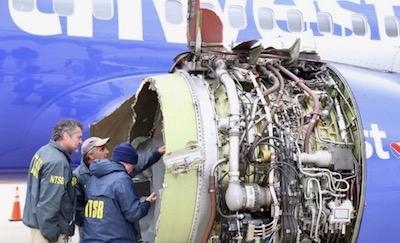Follows Uncontained Engine Failure On SWA 1380
As expected, the FAA has released an emergency AD 2018-09-51 for CFM International S.A. (CFM) Model CFM56-7B engines.

The emergency AD was prompted by a recent event in which a Boeing Model 737-700 airplane powered by CFM56-7B model engines experienced an engine failure due to a fractured fan blade, resulting in the engine inlet cowl disintegrating. Debris penetrated the fuselage causing a loss of pressurization and prompting an emergency descent. Although the airplane landed safely, there was one passenger fatality.
Fan blade failure due to cracking, if not addressed, could result in an engine in-flight shutdown (IFSD), uncontained release of debris, damage to the engine, damage to the airplane, and possible airplane decompression.
The FAA reviewed CFM Service Bulletin CFM56-7B S/B 72-1033, dated April 20, 2018. The service information describes procedures for performing an ultrasonic inspection for cracks of the fan blade dovetail, and removal of cracked fan blades from service.
The FAA is issuing this AD because the agency evaluated all the relevant information and determined the unsafe condition described previously is likely to exist or develop in other products of the same type design.
This AD requires accomplishing the actions specified in the service information described previously, except as discussed below.
CFM Service Bulletin CFM56-7B S/B 72-1033, dated April 20, 2018, provides actions for engines with fewer than 30,000 flight cycles, but this AD does not affect those engines. The service information also specifies repetitive inspections, but this AD does not require that the inspection be repeated. The FAA is considering further rulemaking to address these differences.
- Owners and operators of airplanes with the affected engines are required to comply with this AD within the compliance times specified, unless already done.
- Within 20 days after receipt of this AD, perform a one-time ultrasonic inspection (USI) of all 24 fan blade dovetail concave and convex sides to detect cracking.
- Use the Accomplishment Instructions, paragraphs 3.A.(3)(a) through (i), of CFM Service Bulletin CFM56-7B S/B 72-1033, dated April 20, 2018, to perform the inspection required by this AD.
- If any unserviceable indication, as specified in CFM Service Bulletin CFM56-7B S/B 72-1033, dated April 20, 2018, is found during any inspection required by this AD, remove the affected fan blade from service before further flight.
- Although CFM Service Bulletin CFM56-7B S/B 72-1033, dated April 20, 2018, specifies to report findings, this AD does not include that requirement.
The AD also includes several alternative methods of compliance.
Southwest issued a statement following the release of the AD. " Southwest Airlines acknowledges the issuance of Emergency Airworthiness Directive (AD) 2018-09-51 by the Federal Aviation Administration to airlines operating CFM56-7B engines. The existing Southwest Airlines maintenance program meets or exceeds all the requirements specified in the Airworthiness Directive," the airline said.
(NTSB image)
FMI: AD
 ANN's Daily Aero-Linx (05.02.24)
ANN's Daily Aero-Linx (05.02.24) ANN's Daily Aero-Term (05.02.24): Touchdown Zone Lighting
ANN's Daily Aero-Term (05.02.24): Touchdown Zone Lighting Aero-News: Quote of the Day (05.02.24)
Aero-News: Quote of the Day (05.02.24) ANN FAQ: Contributing To Aero-TV
ANN FAQ: Contributing To Aero-TV NTSB Final Report: Cirrus Design Corp SR20
NTSB Final Report: Cirrus Design Corp SR20



